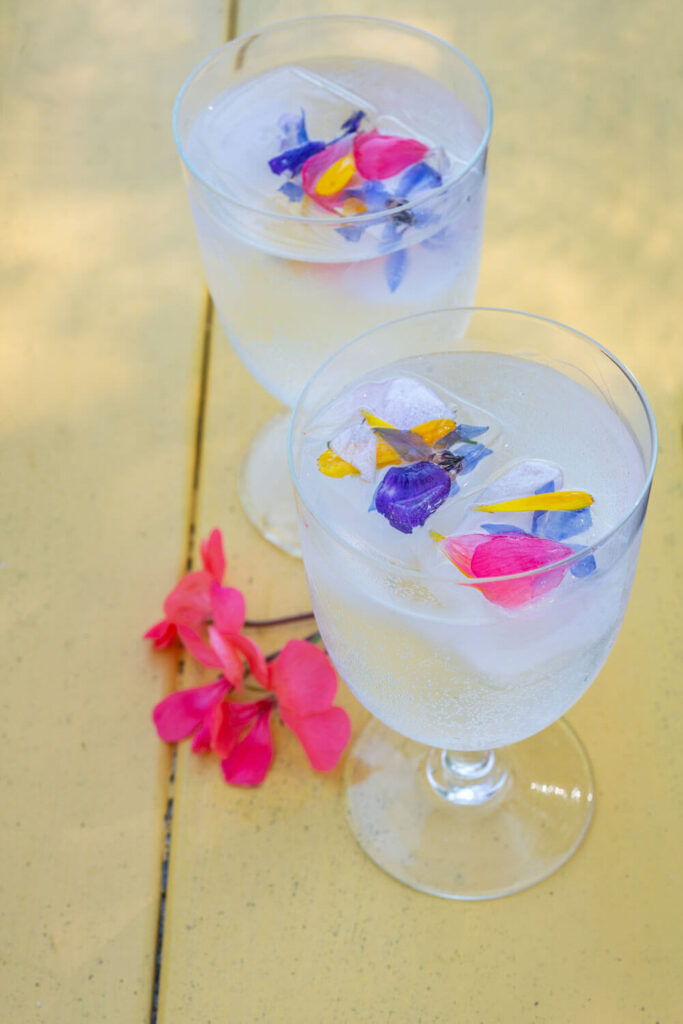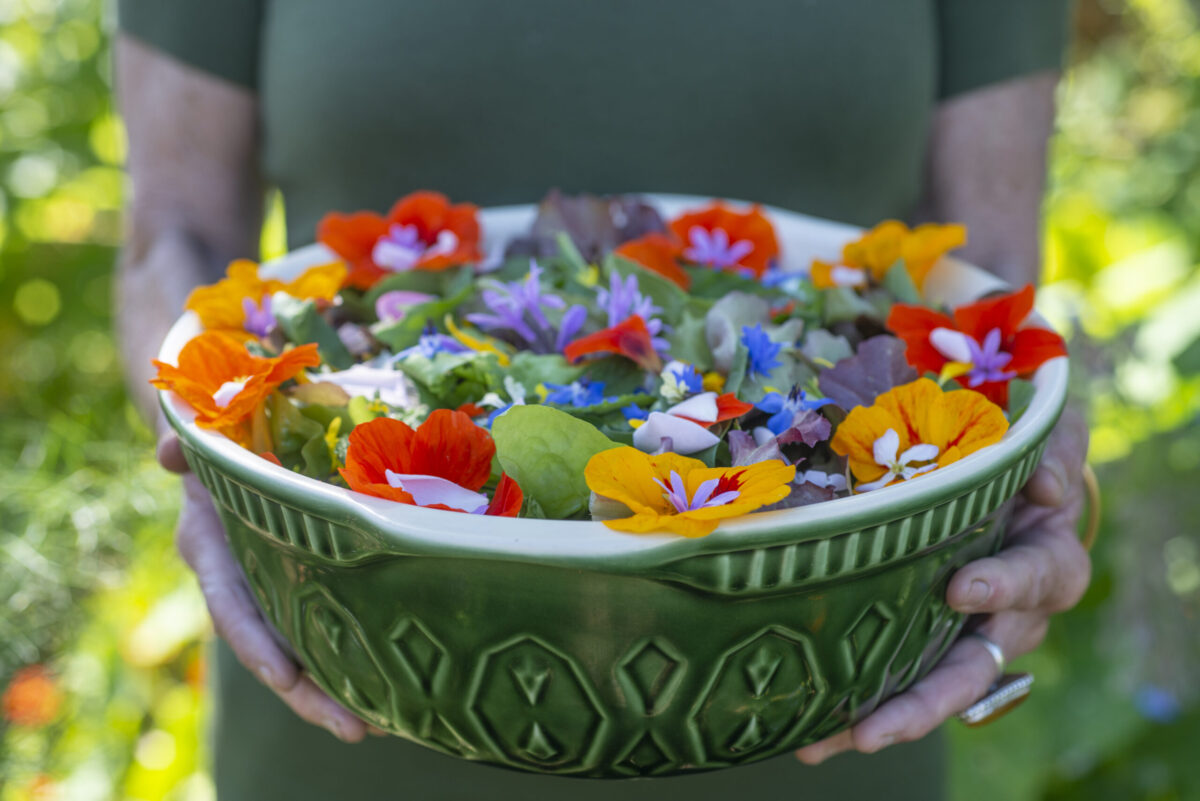words by Sheri Baer
Once upon a time, near a cozy little cottage by the sea, there was a garden where flowers bloomed impossibly bright, bountiful greenery stretched up to the sun and even the smallest, seemingly most insignificant weed felt nurtured and welcome. Carefully tending the patch of land was a woman steeped in the knowledge of wild edibles and medicinal plants, living in harmony with the birds, butterflies and ladybugs drawn to this teeming, vibrant space.
This may sound like the start of a fairytale, but it’s actually an apt description for the natural landscape created by Suzanne Elliott just north of Half Moon Bay. Twenty years ago, when she first moved into her 1940s-era El Granada home, the neglected front yard of the half-acre lot was strewn with car parts and debris. “I dug the whole thing up and transformed it into a garden,” she says. But not just any garden. Here, amid a mix of wild plants, garden herbs and planter beds, surrounded by fragrant lavender, chamomile buds and lemon verbena, Suzanne practices and shares the ancient art and science of herbalism. Under the brand “Woodsorrel,” she teaches classes and workshops and sells her own products, drawing on recipes and traditions forged centuries ago.
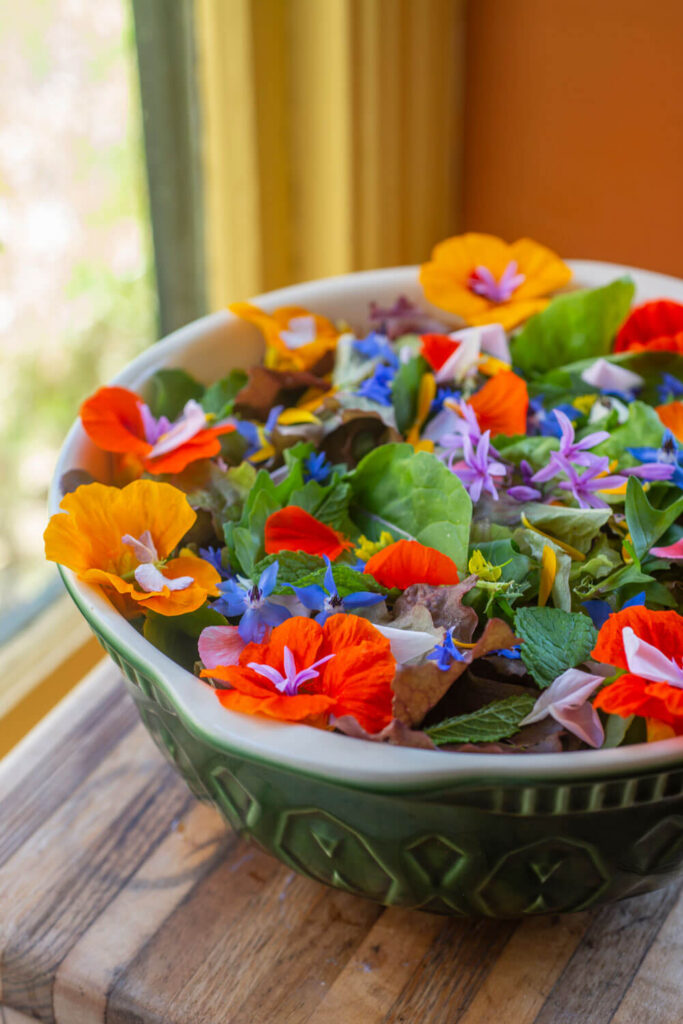
Floral Studded Salad
Flowers and herbs just make me happy! It’s hard not to want to use them for all the meals I serve. It’s so much fun to see the smiling faces of my guests when I present a colorful salad graced with vibrant edible flowers freshly plucked from the garden. Don’t limit their use to just salads—I sprinkle them over many dishes before serving. Fresh leaves of mint, basil and nasturtium can be torn or coarsely chopped and added to the mix for an extra punch of flavor!
Walking out on a guided tour through her garden, Suzanne gestures to the eye-popping visual opus of lush living things. “All of these plants are here for a reason,” she says. “There’s that saying by Ralph Waldo Emerson, ‘What is a weed? It’s a plant whose virtues have not yet been discovered.’ I think we’ve been brainwashed to think that having weeds in your garden is a horrible thing. Probably 85% of what’s in my garden has a purpose.”
Suzanne points to a patch of tufted tall green blades, bearing tiny glints of seeds. “See this tall grass?,” she asks. “This is called wild oat and this makes an amazing tea. It gets really sweet because of the starches, and it’s also really rich in minerals and calcium.” She leans down and picks a few long, skinny pods off another plant. “This is wild radish,” she notes. “This is where our radishes come from; you want to catch these seed pods when they’re really green and tender—they’re delicious.”
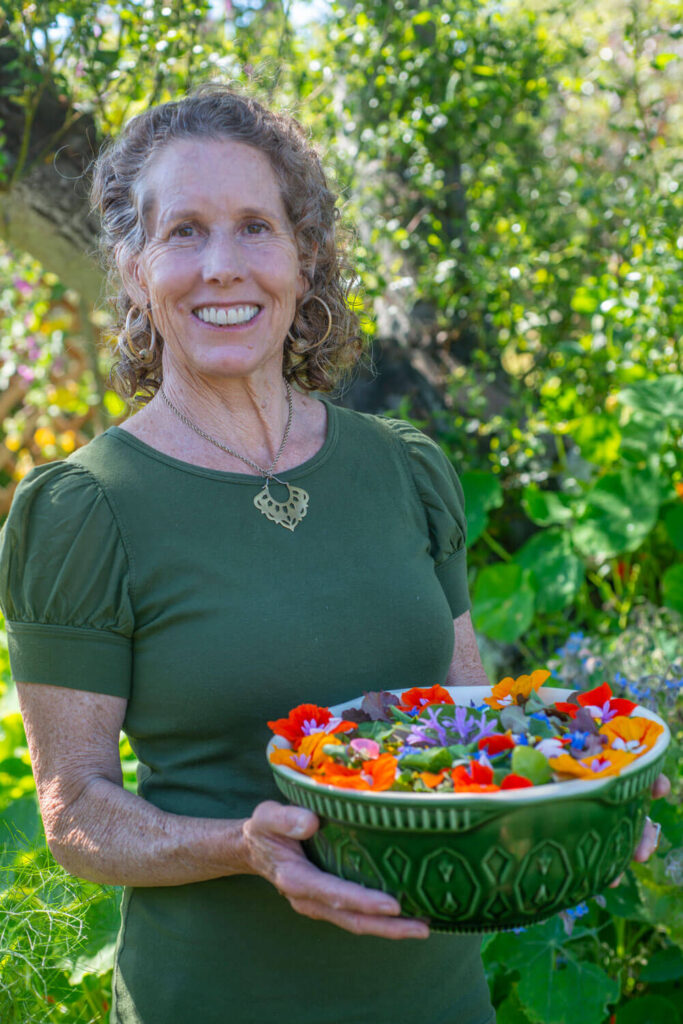
Wild mustard. Mallow. Yellow dock. What the eye disregards as weeds is revealed in a new light as Suzanne moves from one patch of greenery to another. “People tend to not gather wild foods because they don’t know where to begin,” she says. “I don’t separate weeds and garden plants; they’re all plants to me. They’re all part of the whole world of food and medicine.”
It’s a world that started intriguing Suzanne at an early age. Growing up in Pacifica with her parents and three siblings, she credits her mother with teaching her the practical skills that serve her to this day. “I remember learning everything—how to fold clothes, how to make the bed; she had me in the kitchen cutting things up and using a knife,” she says. “She didn’t coddle us. She was very loving but we had to learn how to stand on our own two feet and I had a lot of responsibility as a young person.”
Suzanne enjoyed cooking and took over making the family meals. While she was still in high school, she started working at Half Moon Bay Nursery, where she learned to pot plants, make cuttings and design arrangements like hanging moss baskets. Suzanne made a point of never turning down an assignment. “I would say, ‘Sure, I can do it!’ and that’s been my motto since I was a young person,” she says. “The nursery helped build a foundation when it came to planting and learning how to grow; I also got really interested in herbs while I was there.”
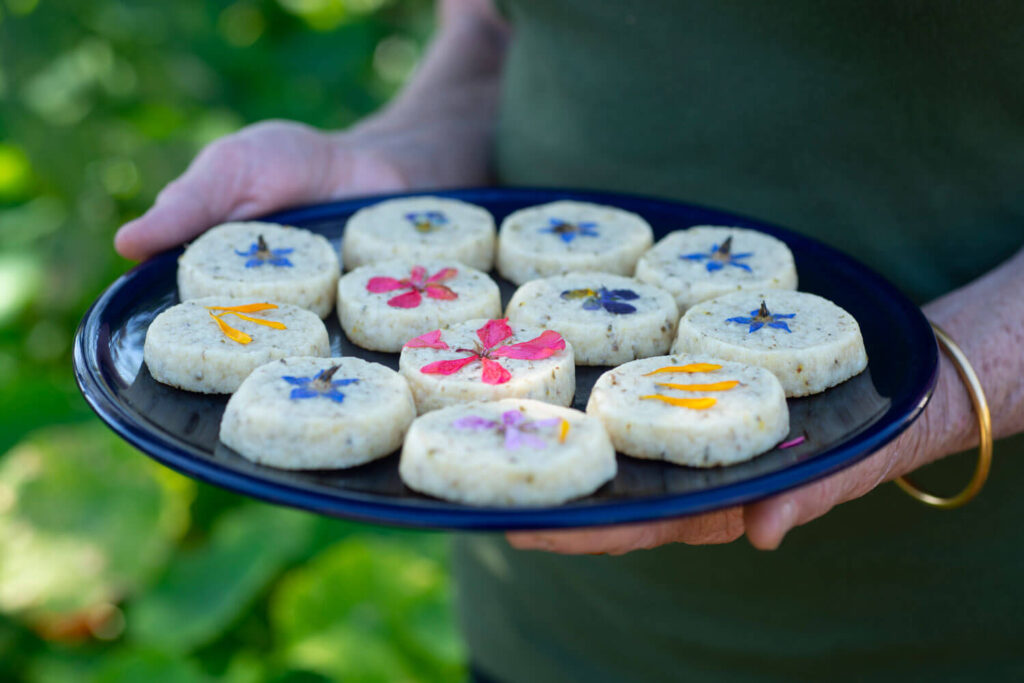
Baked Goods & Desserts
I love to experiment with unusual uses of herbs and edible flowers to create unique flavor combinations. Savory and sweet work well together. Try adding a tablespoon or two of finely minced herbs (such as thyme or rosemary) or flowers (such as rose geranium leaves or lavender flowers) to your favorite shortbread, sugar cookie, scone or cake recipe. For an extra special touch, press a fresh edible flower onto each cookie before baking or garnish a frosted cupcake or cake with colorful blossoms.
When Suzanne graduated high school in 1976, she received two life-changing books: one on Shiatsu massage and the other on herbs, Jeanne Rose’s Herbs and Things. Both resonated deeply with her—she went on to receive her certification in Shiatsu therapy and immersed herself in herbal knowledge, attending Heartwood College in Santa Cruz and studying with renowned experts like Michael Tierra and Rosemary Gladstar. “I thought I could be an herbalist who does intakes with people and helps them with their diets and ailments,” she says. “But I realized I would rather teach people how to be healthy. I really like to share what I know.”
Starting with a class on making herbal cosmetics, Suzanne expanded her offerings to include a variety of workshops and events, along with her signature eight-month course, “Herbal Ways for Women.” Held in a “living classroom” stretching from her own garden and a prolific green divide in her street to nearby coastside discoveries, she takes a hands-on approach, teaching students the art of foraging and how to use the abundant natural bounty around us. “I don’t just use wild plants—I also use garden plants and herbs in non-traditional ways that people don’t think about,” she says, “like rosemary, for instance; you can bake it into cookies, make it into a tea or put it in vinegar.”
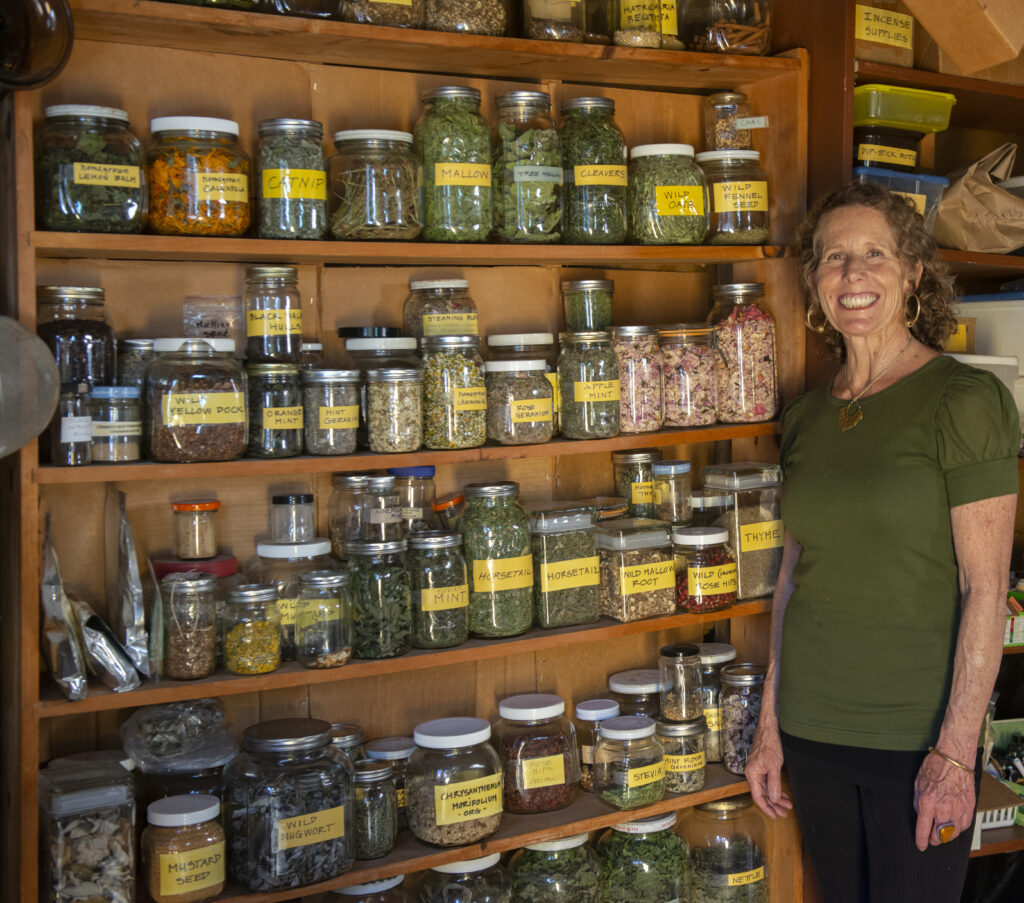
To keep things intimate, Suzanne purposely limits “Herbal Ways for Women” to 10 students, with each month following a seasonal theme. Topics include wild foods cooking, a comprehensive study of medicinal plants, herb garden gastronomy, botanical skin care and herbal medicine making. “My approach is food first and then layer it with the use of herbs,” she notes. “We learn to make tonics, tea blends and medicinal tinctures. The beauty of herbal medicine is that each plant contains dozens of healing properties as opposed to a single action.”
Whether students are whipping up Wild Greens Frittata, Floral Studded Salad or Creamy Mallow Soup, Suzanne also aims to expose the taste buds to new experiences. “When you go to the store, everything is geared to a certain palate, whereas in the wild, things have stronger flavors. That’s because they’re in their natural state; they haven’t been changed or manipulated,” explains Suzanne. “We learn about plants by tasting them, smelling them and touching them. It really helps to expand your repertoire of flavors.”
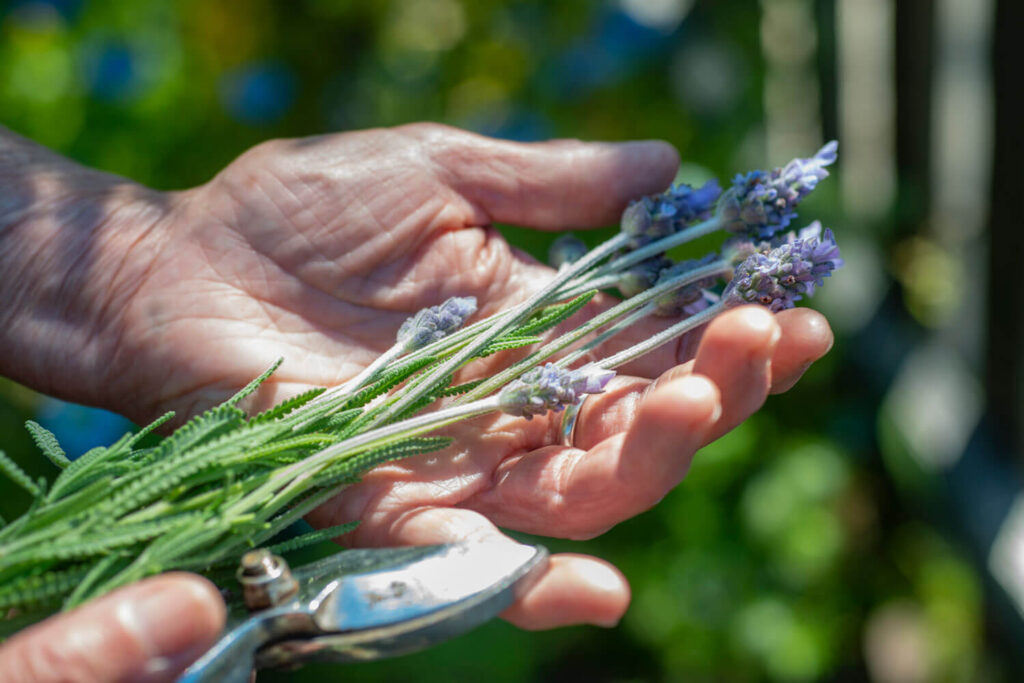
Fresh Tips from Suzanne
Sample edible flowers: Viola, pansy, calendula, day lily, nasturtium, dandelion, lavender, scented geranium, geranium, borage, arugula, sweet violet and fragrant roses.
Sample herbs: Chives, society garlic, thyme, rosemary, basil, sage and mint.
Sample wild plants: Wild radish, wild mustard and fennel.
Note: Be sure your edible flowers have not been sprayed with pesticides. To wash: Fill a bowl with cold water and carefully swish the flowers in water so as not to bruise them. To dry: Take each flower at its base and gently shake off excess water.
In addition to teaching classes and workshops, Suzanne also fills her days concocting Woodsorrel herbal delicacies and handcrafted body and bath products. Tucked behind her cozy cottage is a shed-like structure she refers to as her herb room or apothecary. Folders and binders overflow with recipes and instructions, and shelves are stacked with dozens of glass canning jars, bottles and canisters. Homegrown rosemary and thyme are here, along with more exotic-sounding ingredients like wild mugwort and mallow root. “About half of these plants I gather wild,” she says. “I try to forage and grow as much as I can because it’s just better quality and it’s fun.”
Artfully packaging her wares, Suzanne sells to wholesale clients and at seasonal pop-up marketplaces she co-hosts with Half Moon Bay ceramic artist Catherine Henry. Herbal libations might include elderberry rose cordial, ginger vodka and figgy brandy. There’s triple rose moisture cream, wild mugwort oil and Turkish soothing bath salts. Any fruits that come her way transform into fanciful marmalades and jams. “I like to add different flavor elements,” Suzanne says. “For my apple jellies, I will use rose geranium or lemon verbena or sometimes lavender with rose hips and rose petals.”
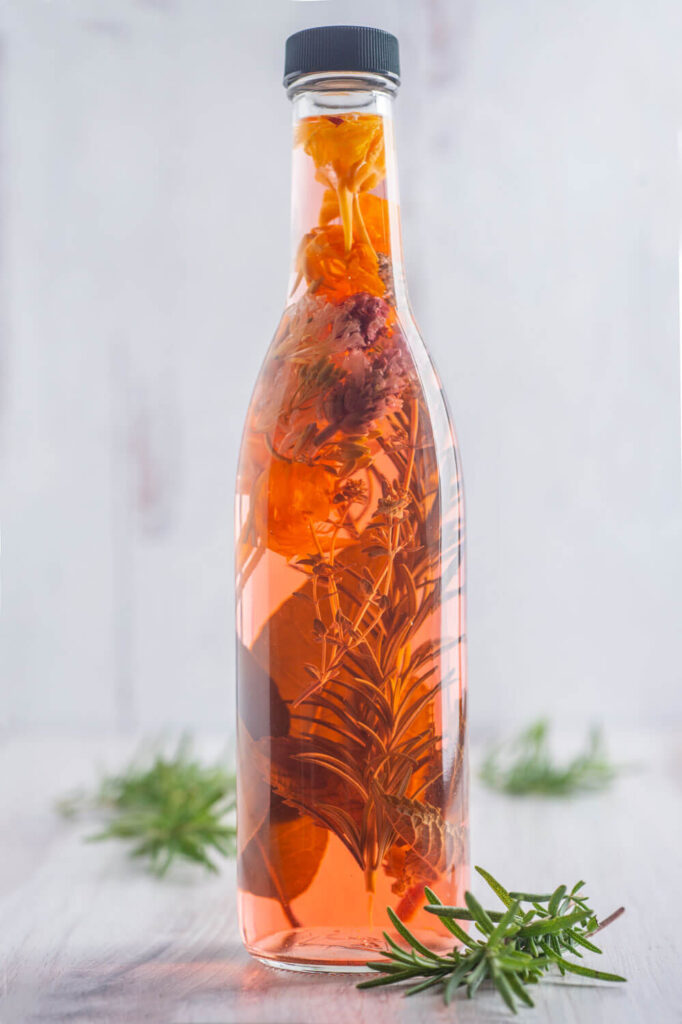
Over rose geranium scone bites and steaming mugs of “Cottage Garden” tea blend sweetened with homegrown stevia, Suzanne talks about the rhythm of life as an herbalist. “I follow the seasons and every day I’m out there gathering something,” she says. “The whole experience of being out in nature is so healing. Herbalism is a lifestyle, really. I do it because I can’t not do it. It comes from a place deep inside of me.”
Suzanne acknowledges that maintaining a garden that welcomes the wild requires a lot of upkeep but the effort both fuels and feeds her. Looking out over the splashes of dandelion, Queen Anne’s lace and flowering tree mallow, she recognizes so many familiar friends, along with some surprising new ones. “I have a hand in it but nature plays a big part,” she reflects. “A lot of the plants that have grown here I’ve planted but many of them have just appeared—it’s kind of like a magic garden.”
Which seems apropos for this fairytale-like setting by the sea.
